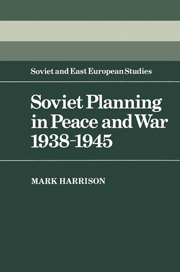Book contents
4 - THE SEARCH FOR ECONOMIC BALANCE IN WARTIME
Published online by Cambridge University Press: 29 October 2009
Summary
Friction is the only conception which in a general way corresponds to that which distinguishes real War from War on paper. The military machine, the Army and all belonging to it, is in fact simple and appears on this account easy to manage. But let us reflect that no part of it is in one piece, that it is composed entirely of individuals, each of which keeps up its own friction in all directions. Theoretically all sounds very well: the commander of a battalion is responsible for the execution of the order given; and as the battalion by its discipline is glued together into one piece, and the chief must be a man of acknowledged zeal, the beam turns on an iron pin with little friction. But it is not so in reality …
(Carl von Clausewitz)INTRODUCTION
In Chapter 1 it was stated that the real purpose of planning is to enable the continuous adaptation of the economic system to changing reality according to permanent objectives. The most important problem of central planning in the Soviet Union was given as the failure to adapt plans smoothly and continuously to the resources really available and to the real conditions under which they would be supplied. Adaptation of plans does take place, but it occurs discontinuously under the pressure of accumulated imbalances. Plans are formulated on the basis of existing knowledge and put into operation. In the course of implementation possible difficulties are revealed and new information is generated. But because of a multitude of frictions the information is at first discounted, the difficulties denied by those in charge of the plan.
- Type
- Chapter
- Information
- Soviet Planning in Peace and War, 1938–1945 , pp. 165 - 221Publisher: Cambridge University PressPrint publication year: 1985



